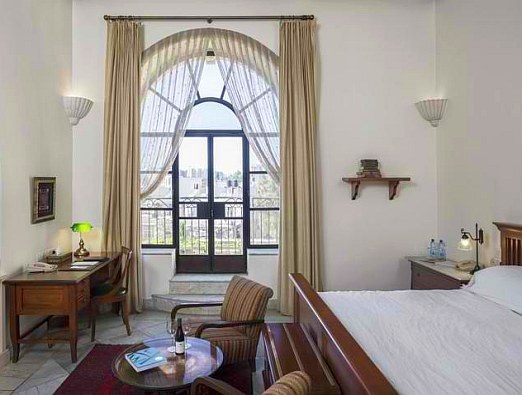The History of the American Colony Hotel - A Thriving Commune
This is the second entry in a GoJerusalem.com series on the history of the American Colony Hotel.This event has ended
Click here to view this week top events >
This is the second entry in a GoJerusalem.com series on the history of the American Colony Hotel. Soon after arriving in Jerusalem, the American presence was bolstered by the arrival of dozens of new Swedish members, and soon the Colony was a thriving commune, a center of industry whose members ingratiated themselves with Jerusalem's residents and provided a welcome outpost for American culture in Ottoman Palestine. But these happy days were numbered - the Middle East was about to change forever.
The American Colony of 1881 was not a hotel, but the name given to Spafford's small community of faithful, who organized their lives according to communal principles, sharing property and living space in a house in the Old City, near Damascus Gate. Muslim and Jewish residents of the city, wary of missionaries, were initially suspicious of the new American arrivals, but the residents' generous nature, humble lifestyle and lack of interest in proselytizing soon won over their neighbors.
Horatio Spafford died of malaria in 1888, but the Colony continued to thrive, and indeed soon expanded dramatically when Anna Spafford, on a trip back to Chicago in 1894, impressed the local Scandinavian community (of which she herself, a Norwegian immigrant, had been part) with tales of the Colony's life in Jerusalem. Seventy enthusiastic members of the Chicago Swedish Evangelical Church followed Anna Spafford back to Jerusalem. Later that year, the Swedish contingent imported many family members from Sweden to Jerusalem, enlarging the community by another 67 souls. By now numbering well over 150, the American Colony was in dire need of new quarters, and the now-empty estate of Rabbah Daoud Amin Effendi El Husseini fit perfectly.
With the new blood and new quarters, the Colony prospered, establishing within the grounds of El Husseini's mansion a farm and dairy, a bakery, a space for jarring pickles and preserves, a carpenter's shop, a smithy, one of Jerusalem's first photography studios (fittingly named The American Colony Photo Department) and a business selling crafts and archaeological artifacts - all while continuing the philanthropic activities that had endeared them to the residents of Jerusalem.
The Colony's lifestyle at this time in fact presaged the development of the more famous example of communal living in the Holy Land, the kibbutz system; according to Hebrew University's Professor Ruth Kark, an expert on the history of Jerusalem and author of a book on the Colony called Scenes from a Jerusalem Saga, it was "something very unique in Palestine, to have such a religious commune which behaved like a kibbutz in a way. They were running their lives as a commune. They had meetings every day, they had a communal dining room and kitchen, all the money went into the commune, all the properties that the Swedes sold in Sweden went into the common cash fund."
Although many of the so-called American Colony's members were now of Swedish extraction, the Colony established itself as a center of American lifestyle in a Middle Eastern milieu, maintaining friendly relations with the other outpost of America in Jerusalem, the nearby American Consulate. The school in particular was popular, attracting pupils from both the Jewish and Arab communities.
Kark explains that the American Colony "was sort of a little American island in Palestine, in the Holy Land. They celebrated the 4th of July. They had all kinds of interesting habits, musical, educational habits, their own school, their own medical facility because they did not believe actually in getting any outside medical treatment" in the early years of the compound (both renowned ophthalmologist Abraham Albert Ticho, who would go on to be more famous as the husband of artist Anna Ticho, and pioneering Jerusalem pediatrician Dr. Helena Kagan would later become regular medical consultants at the American Colony during the Mandate era).
As the Colony's economic and cultural activities in Jerusalem expanded, they transitioned from leasing the Pasha House to eventually owning it, acquiring the adjoining buildings as well, the extra space allowing the Colony to double in the winters as a hotel for the guests of British noble Baron Ustinov (grandfather of actor Peter Ustinov), who owned the prominent Hotel du Parc in Jaffa, but needed Western-standard lodging in Jerusalem for European and American travelers. Thus were laid the roots of the American Colony Hotel, but before the era of the hotel could truly begin, the Colony and the city of Jerusalem would weather years of brutal conflict as the map of the Middle East was redrawn.
2000+ tips and recommendations
Jerusalem, the city where kings ruled and sultans sat is no stranger to luxury. Today, even the visiting yeoman can find...
Jewish tradition holds that in the times of the First and Second Temples, all the Jewish people would gather in Jerusalem...
Technically, it's possible to visit Jerusalem without going to the Old City, but it would be hard to say you'd...
Looking for a place to begin your morning in luxury and style? Look no further than the American Colony Hotel, which offers...
The faithful may rhapsodize about the spiritual highs to be reached in the Old City; culture cognoscenti groove on the...
Once upon a time, options for eating out in Jerusalem were limited to local common phenomena such as falafel and schwarma,...
No results to show





|
Text text text
|
||